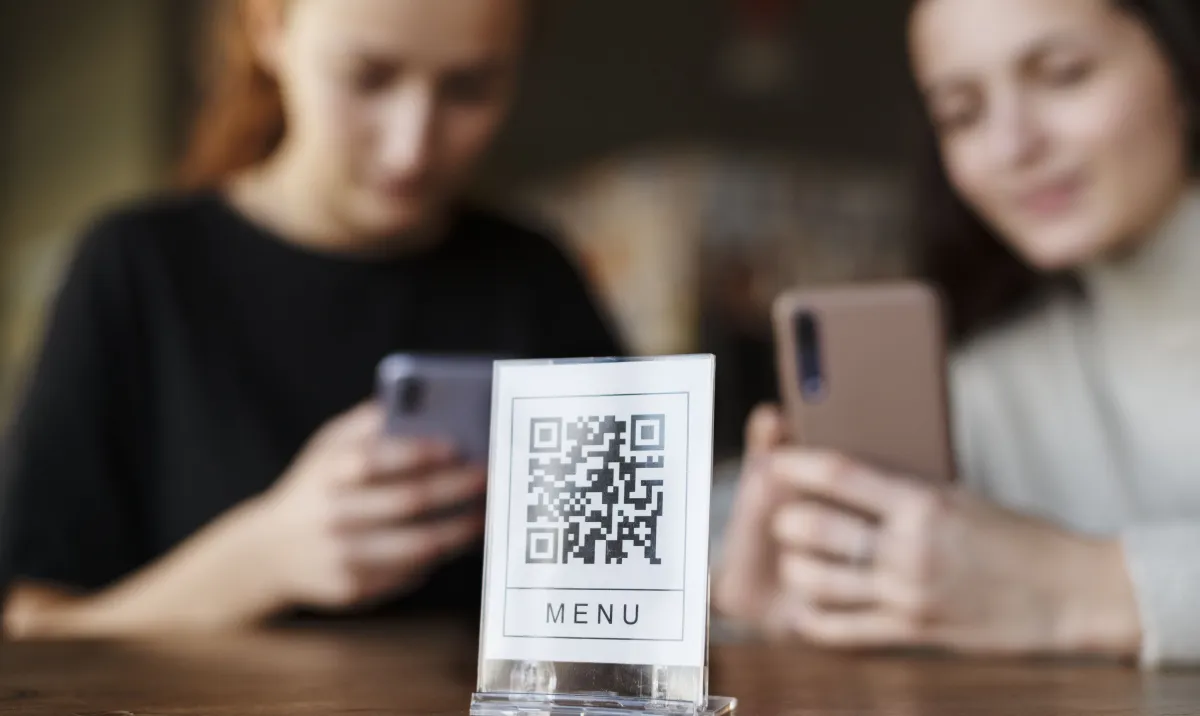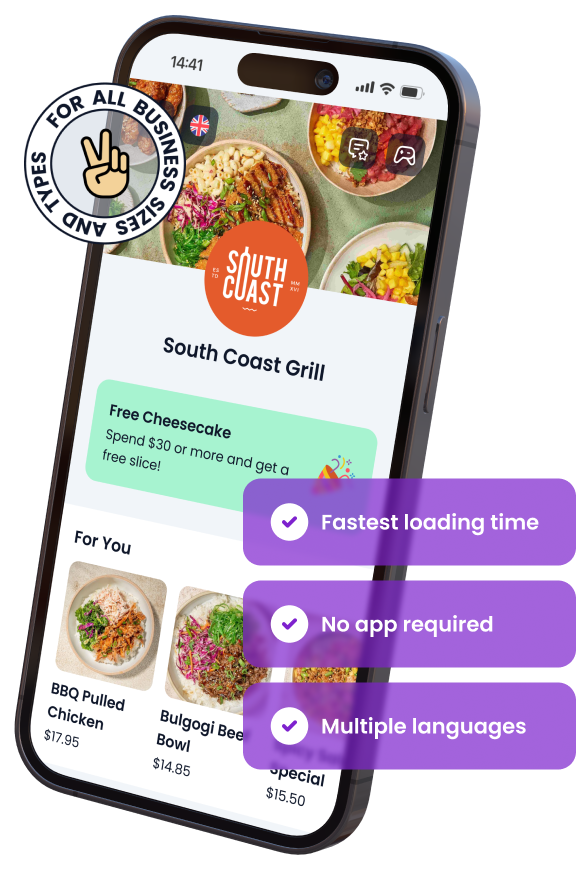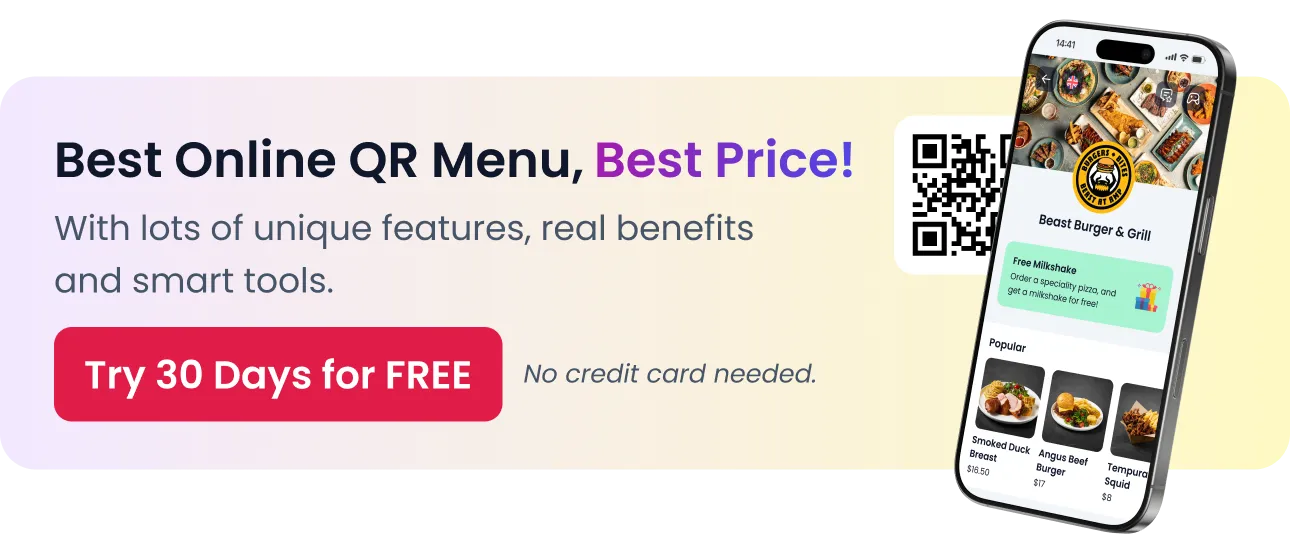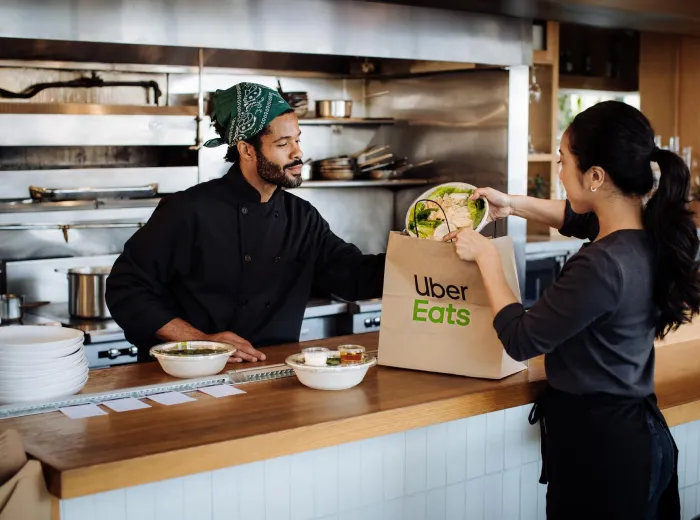

Top Reasons to Switch from PDFs to Online QR Menus
In today’s fast-changing restaurant industry, flexibility and speed aren’t just nice to have — they’re essential. For years, many restaurants and cafes have relied on static PDF menus, whether posted on their websites or linked through QR codes on tables. At first glance, PDFs seemed like an easy digital solution: cheap, familiar, and simple to upload. But as technology — and customer expectations — evolve, these old-school PDFs are starting to show their limits.
The truth is, the way diners interact with menus has changed dramatically. Customers now expect instant, seamless access to menus that are easy to navigate, visually engaging, and always up to date. Static PDFs simply can’t keep up with these demands. More importantly, clinging to them could quietly be costing your business money, sales, and valuable opportunities.
If you’ve been wondering whether it’s time to ditch your PDF menu in favor of a dynamic online QR menu, this guide will walk you through everything you need to know. From guest experience and operational ease to marketing, SEO, and profitability — we’ll explore why thousands of restaurant owners have already made the switch and how you can do the same smoothly.
Why So Many Restaurants Are Moving Away from PDFs
PDF menus had their moment — but for many restaurants, that moment has passed. The shift away from PDFs isn’t just about following trends; it’s about meeting new customer expectations, reducing operational headaches, and unlocking new opportunities for engagement and revenue. Let’s take a closer look at why so many restaurant owners are making the change.
Changing Customer Habits Post-Pandemic
The COVID-19 pandemic dramatically accelerated the use of digital tools in restaurants. Customers got used to scanning QR codes, browsing menus on their phones, and minimizing physical contact. Now, even as restrictions have eased, these habits have stuck.
- Customers expect contactless access as the norm.
- Digital ordering has become a default behavior, especially for younger diners.
- Many guests now prefer menus they can easily browse and share on their phones.
Restaurants that continue using PDFs may seem outdated or behind the curve — potentially pushing customers toward more tech-savvy competitors.
The Rise of Mobile-First Dining Experiences
Today’s diners aren’t just looking at menus on mobile devices — they’re making entire dining decisions there. From finding restaurants to browsing dishes and placing orders, everything is happening through a mobile-first lens.
- Over 60% of online searches for food are done on smartphones.
- Mobile-friendly interfaces are expected, not optional.
- Diners want menus that are fast, intuitive, and visually appealing on any screen.
PDF menus are clunky on mobile. They often require excessive scrolling, pinching, and zooming — creating unnecessary friction and reducing guest satisfaction.
The Problem with Old-School PDF Menus
While PDFs might seem like a “set it and forget it” option, they come with significant downsides for both customers and restaurant owners.
Common issues with PDF menus:
- Slow loading — especially on mobile data connections.
- Poor readability on smaller screens due to tiny fonts or wide layouts.
- No interactive features like search, filtering, or item highlighting.
- Limited ability to integrate with online ordering or promotions.
In short, PDF menus offer none of the dynamic, engaging experiences that today’s diners expect — and they can quietly cost your business in lost sales and lower guest satisfaction.
The Hidden Costs of Sticking with PDFs
Many restaurant owners stick with PDF menus thinking they’re saving time and money — but in reality, PDFs can quietly drain your resources in ways that aren’t always obvious upfront. From operational inefficiencies to missed revenue opportunities, the hidden costs of PDFs often outweigh their perceived convenience. Here’s what most owners overlook.
Time Wasted on Frequent Edits
Every time you need to update your menu — whether it’s changing prices, adjusting ingredients, or adding seasonal items — PDF menus require a manual, often tedious editing process.
Common time-wasters with PDF menus:
- Reopening design software or hiring a designer.
- Making layout adjustments for even small changes.
- Uploading new files to your website or reprinting QR codes.
What should be a quick update can easily turn into a multi-hour task, slowing down your operations and pulling your focus from higher-value work.
Printing Costs That Sneak Up
Even though PDFs are digital, many restaurants still end up printing physical versions to display QR codes or keep paper copies available for customers who don’t want to scan.
Unexpected expenses from PDF menus:
- Frequent reprints for new QR codes if the menu file changes.
- Printing backup paper menus for staff and guests.
- Costs of design adjustments every time you need to reprint.
These costs add up quickly, especially if your restaurant updates its menu often or runs regular promotions.
Missed Sales Opportunities
PDFs simply aren’t built to sell — they’re static, and they don’t guide customers toward higher-margin or featured items.
Revenue lost with PDF menus:
- No ability to promote daily specials or limited-time offers.
- No upselling prompts or suggestions for add-ons and combos.
- No way to showcase bestsellers or customer favorites dynamically.
Without the ability to gently steer customers toward certain items, you’re likely leaving money on the table — often without even realizing it.
How Online QR Menus Drive More Orders
Unlike static PDFs, online QR menus are designed to actively boost customer spending. They’re not just a replacement for paper menus — they’re powerful sales tools that guide diners toward specific choices, increase average ticket sizes, and improve the overall dining experience. Here’s how they work behind the scenes to drive more orders.
Easy Upselling and Smart Recommendations
Online QR menus can automatically suggest complementary items based on what the customer is viewing or ordering.
Examples of smart upselling features:
- Recommending appetizers, sides, or drinks with main courses.
- Suggesting premium upgrades like extra toppings or larger sizes.
- Promoting dessert pairings right after entrée selections.
These subtle prompts lead to higher check totals without feeling pushy — they simply present more options at just the right moment.
Highlighting Promotions in Real Time
Unlike PDFs, online QR menus let you promote time-sensitive offers instantly, without needing to redesign or re-upload anything.
Ways online menus boost promo visibility:
- Flashing banners or pop-ups for limited-time deals.
- Automatically showing happy hour prices during designated hours.
- Easily switching out featured items based on availability or seasonality.
This flexibility lets you move quickly, testing promotions and driving sales during slow periods — something PDFs simply can’t do.
Visual Impact with Photos and Badges
Customers eat with their eyes first, and online menus take full advantage of this with vibrant photos and helpful visual cues.
Key visual features that boost orders:
- High-quality food photos to entice appetite-driven choices.
- Dietary and allergen badges (e.g., vegan, gluten-free, spicy) to simplify decision-making.
- Icons for bestsellers, chef’s specials, or staff picks to guide selections.
These visuals not only make your menu more attractive but also reduce ordering friction — leading to quicker decisions and larger orders.
SEO Isn’t Just for Websites — Menus Matter Too
Many restaurant owners mistakenly think SEO only applies to their main website or social media profiles. In reality, your menu itself can — and should — be a powerful SEO tool. Switching to an online QR menu opens up opportunities to boost your restaurant’s visibility in search results, attract new diners, and drive more traffic, both online and in person. Here’s how.
Why Searchable Menus Bring in New Customers
One of the biggest drawbacks of PDF menus is that search engines like Google can’t easily index their content. This means your dishes, ingredients, and prices are invisible to potential customers searching online.
Benefits of searchable online menus:
- Appear in “near me” searches for specific dishes or cuisines.
- Show up in Google search results for popular items (e.g., “best vegan burger in [city]”).
- Increase organic website traffic from hungry locals and tourists.
Simply put, a searchable menu makes it easier for people to find exactly what you offer — before they even visit your restaurant.
Helping Tourists and Locals Discover Your Dishes
Online QR menus often come with built-in multilingual features, allowing you to present your dishes in multiple languages — a huge advantage in tourist-heavy areas.
Advantages of multilingual digital menus:
- Attract international visitors looking for familiar or specific dishes.
- Reduce language barriers that can prevent ordering.
- Improve online visibility in different languages through SEO.
This not only enhances guest comfort but also positions your restaurant to compete more effectively in global search results.
Boosting Google Business Profile Performance
Your Google Business Profile (formerly Google My Business) is a crucial piece of your online presence. Linking your online menu to your profile can directly improve how often you show up in local search results.
Benefits of connecting your QR menu to your Google Business Profile:
- Higher placement in “nearby” and “best restaurants” searches.
- Increased clicks on your profile thanks to accessible menus.
- Enhanced trust from customers who see an updated, easy-to-browse menu.
Many online menu platforms even integrate automatically with Google, ensuring your latest offerings are always visible to searchers — something PDFs can’t do.
Helpful link:
Google Business Profile Help Center — Learn how to manage your restaurant’s online presence.
Speed, Convenience, and Guest Experience
At the heart of every great restaurant visit is a smooth, enjoyable guest experience. Today’s diners expect speed and ease at every step — from browsing the menu to placing their order. Online QR menus are designed with exactly that in mind, delivering fast, convenient, and frustration-free interactions that PDFs simply can’t match. Here’s how they elevate the dining journey.
Faster Load Times, Smoother Browsing
PDF menus are notorious for slow load times, especially on mobile networks or older devices. Online QR menus, however, are optimized for quick access.
Key speed advantages of digital menus:
- Menus load almost instantly, even on mobile data.
- Guests can start browsing without long wait times or download prompts.
- No need for additional apps or file readers — just a simple tap.
This fast, seamless access makes customers more likely to explore the menu fully and order more confidently.
No More Pinch-and-Zoom Frustrations
We’ve all experienced the awkwardness of trying to pinch, zoom, and scroll through a cluttered PDF on a phone. It’s a major barrier to ordering — and it’s completely avoidable.
How online QR menus improve navigation:
- Clean, mobile-friendly layouts that adapt to any screen size.
- Simple tap-to-expand sections for categories like appetizers or drinks.
- Easy back-and-forth browsing without losing your place.
Guests can browse comfortably, making the process faster and far less frustrating — especially during busy meal periods.
Accessibility and Inclusivity Benefits
Online QR menus also help create a more inclusive environment by offering better accessibility options than PDFs.
Accessibility advantages of digital menus:
- Compatibility with screen readers for visually impaired diners.
- Adjustable font sizes and high-contrast modes on many platforms.
- Language switching to accommodate non-native speakers.
By offering a more accessible, user-friendly experience, you’re not only complying with best practices — you’re also showing your guests that everyone is welcome and valued at your restaurant.
Real-Time Control for Restaurant Owners
One of the most valuable — and often overlooked — benefits of switching to an online QR menu is the ability to take full control of your menu in real time. Unlike static PDFs that require manual updates and re-uploads, digital menus give you instant flexibility, allowing you to adapt on the fly, save time, and manage your business more efficiently. Here’s where the real power lies.
Instantly Update Items, Prices, or Availability
In a busy restaurant, things change fast — from ingredient shortages to price adjustments. Online QR menus let you react immediately.
Tasks you can handle in seconds:
- Pause or hide out-of-stock items temporarily.
- Adjust pricing during supply cost changes or promotions.
- Add new dishes or remove old ones instantly.
This immediate control reduces guest frustration from unavailable items and ensures your menu is always accurate — no awkward “sorry, we’re out” moments.
Seasonal Changes Without the Hassle
Running seasonal specials or rotating menus becomes far easier when you’re not stuck dealing with PDFs.
Benefits for seasonal or rotating menus:
- Quickly switch to summer, winter, or holiday menus with a few clicks.
- Test new dishes without committing to reprinting costs.
- Schedule menu changes in advance to align with marketing campaigns.
This allows you to stay agile and creative with your offerings, keeping your menu fresh and exciting year-round.
Centralized Management for Multi-Location Brands
If you operate multiple locations, online QR menus simplify management across all your sites — something PDFs struggle to handle.
Advantages for multi-location operators:
- Make updates across all locations from a single dashboard.
- Offer location-specific menus, prices, or hours as needed.
- Maintain brand consistency while allowing local flexibility.
This centralized control saves countless hours of coordination and helps ensure every guest — no matter the location — receives the right menu at the right time.
Going Beyond Menus — More Revenue Tools Included
Online QR menus aren’t just about showing dishes — they’ve evolved into full-fledged revenue engines. Many platforms now offer built-in features that help restaurants boost sales, increase customer loyalty, and streamline operations. Here’s how these digital tools go far beyond what a static menu or PDF can offer.
Loyalty Programs and Digital Coupons
Many online menu systems integrate with loyalty programs and discount tools, letting you reward repeat customers directly through the menu.
Examples of loyalty and coupon features:
- Offer points or rewards for repeat visits or large orders.
- Send exclusive discounts for customers who order through the menu.
- Auto-apply promotions for certain order combinations or spending thresholds.
This seamless integration encourages diners to keep coming back — and to order more when they do.
Built-In Online Ordering and Table Reservations
One major advantage of online QR menus is that they can also handle orders and reservations, removing the need for third-party apps.
Convenient add-ons available with many QR menus:
- Let customers order directly from the table without waiting for staff.
- Accept takeout or delivery orders via the same menu link.
- Enable table reservations, cutting down on phone calls and manual bookings.
This functionality not only improves efficiency but also keeps more revenue in-house by reducing reliance on external ordering platforms.
Data and Insights That PDFs Can’t Provide
One of the biggest missed opportunities with PDFs is the complete lack of data. Online QR menus, on the other hand, offer robust analytics that can help shape smarter business decisions.
Types of valuable data you can gather:
- Track which menu items get viewed most — even if they aren’t ordered.
- See which promotions or upsells perform best.
- Analyze ordering patterns by day, time, or location.
Armed with these insights, you can fine-tune your menu, adjust pricing, and improve your marketing — all with hard numbers guiding you.
Common Myths That Hold Restaurants Back
Despite the many advantages of online QR menus, some restaurant owners hesitate to make the switch — often because of outdated assumptions or misinformation. Let’s break down the most common myths that keep restaurants stuck with PDFs and explain why these concerns rarely hold up in practice.
“Our Customers Don’t Like Technology”
Many owners worry that older guests or less tech-savvy customers will reject digital menus. However, reality shows otherwise.
Here’s the truth:
- QR code scanning is now widespread and familiar to nearly all age groups.
- Most smartphones automatically recognize QR codes without extra apps.
- Simple, user-friendly menu platforms are designed to be intuitive for everyone.
Even older diners, once hesitant, have become comfortable with QR menus — especially when staff are ready to assist if needed.
“It’s Too Expensive or Complicated to Set Up”
Some owners assume that setting up an online QR menu requires a big investment or technical skills. In most cases, this is far from true.
Why this concern is outdated:
- Many platforms offer low monthly fees or even free plans with basic features.
- Setup usually involves uploading your menu, organizing categories, and generating a QR code — no coding required.
- Most providers offer customer support to walk you through setup.
What once took weeks and a web developer can now often be done in an afternoon by restaurant staff.
“We Already Have a Website — That’s Enough”
Having a website is important — but it’s not the same as having a mobile-optimized, interactive menu.
Key differences between a website and a digital QR menu:
- Websites often link to a PDF menu, which still has all the same usability issues.
- Online QR menus are optimized for ordering, browsing, and quick updates, while most websites are static.
- QR menus offer upselling, loyalty tools, and instant updates that websites can’t provide without custom integrations.
Relying solely on your website limits your ability to boost in-person dining experiences and take advantage of mobile-first ordering habits.
Simple Steps to Make the Switch Smoothly
Transitioning from a PDF menu to an online QR menu doesn’t have to be overwhelming. In fact, with the right approach, most restaurants can make the switch quickly and with minimal disruption. Here’s a step-by-step guide to help you upgrade smoothly and start reaping the benefits right away.
Choosing the Right QR Menu Platform
Not all QR menu solutions are created equal. It’s important to pick a platform that fits your restaurant’s specific needs and budget.
Key factors to consider:
- Ease of use: Look for a simple dashboard where you can easily update items.
- Customization: Check if you can adjust design elements to match your brand.
- Features: Prioritize tools like upselling, loyalty programs, and online ordering if those matter to your business.
- Support: Choose a provider with responsive customer support and clear setup guides.
- Cost: Compare plans carefully — some platforms offer free tiers, while others charge based on usage or features.
Tip: Avoid platforms that lock you into long-term contracts until you’ve tested them thoroughly.
Setting Up and Optimizing Your Menu
Once you’ve chosen a platform, the next step is to upload and organize your menu in a way that maximizes ease of use and sales.
Steps to set up your digital menu:
- Organize menu categories clearly (e.g., Appetizers, Mains, Desserts, Drinks).
- Add high-quality photos for key items — this can significantly boost sales.
- Use clear, concise descriptions that highlight ingredients and flavors.
- Enable features like allergen icons, dietary tags, or special badges (e.g., “Bestseller”).
- Test the mobile view thoroughly to ensure everything displays correctly on all devices.
Pro tip: Keep the structure simple — too many categories or subcategories can overwhelm customers.
Training Your Team for a Seamless Rollout
A smooth guest experience starts with a well-prepared team. Before going live, take time to train your staff on how to introduce and explain the new system.
Staff training essentials:
- Teach servers how to explain the QR code process to customers politely and confidently.
- Show staff how to assist guests who may struggle with scanning or navigating.
- Review basic troubleshooting, like refreshing a page or reconnecting to Wi-Fi.
- Encourage staff to gather guest feedback about the new menu experience.
When your team is fully on board, the transition becomes much smoother — and customers will feel supported from the start.
Final Thoughts — Is It Time to Move Beyond PDFs?
Making the switch from PDF menus to online QR menus isn’t just a tech upgrade — it’s a strategic business move. While PDFs may have served their purpose in the past, they now lag behind in terms of guest experience, flexibility, and sales potential. However, that doesn’t mean every restaurant must abandon them immediately. Here’s how to assess whether it’s the right time for your business.
When Sticking to PDFs Makes Sense (Rare Cases)
In some very specific situations, sticking with a PDF menu may still work — though these cases are becoming increasingly rare.
Possible exceptions:
- Fine dining restaurants with fixed, seasonal tasting menus that change infrequently.
- Venues where the menu is intentionally simple and requires little to no updates.
- Locations with extremely limited or no internet connectivity.
Even in these cases, many upscale restaurants are still embracing digital menus for their flexibility and data insights, so it’s worth evaluating regularly.
Signs You’re Ready to Upgrade
For most restaurants, the signs that it’s time to move beyond PDFs are easy to spot — and often hard to ignore.
Key indicators you’re ready for a digital menu:
- You frequently change menu items, prices, or specials.
- You want to promote limited-time offers, events, or seasonal dishes.
- Your guests are already scanning QR codes at their tables.
- You rely on delivery, takeout, or mobile ordering.
- You’re frustrated by the time or cost of constantly updating your PDF menus.
If any of these resonate, it’s likely your business would benefit from an online QR menu right away.
Quick Recap: Key Benefits to Remember
To wrap it all up, here’s a fast recap of why so many restaurants are moving away from PDFs:
- Boosts guest satisfaction with faster, smoother browsing.
- Saves time and money by making updates instant and effortless.
- Drives higher sales through upselling, promotions, and visual appeal.
- Improves discoverability through search engine optimization.
- Unlocks valuable data and advanced revenue tools.
At the end of the day, switching to an online QR menu isn’t just about keeping up with trends — it’s about staying competitive, efficient, and customer-focused in today’s restaurant landscape.
Key Takeaways
If you’re still on the fence about switching from PDFs to online QR menus, here’s a quick summary of the most important points to remember from this guide:
- Customer expectations have changed — diners now prefer fast, mobile-friendly, and interactive menu experiences.
- PDF menus create hidden costs, from constant editing headaches to missed opportunities for upselling and promotions.
- Online QR menus actively drive sales with features like smart recommendations, promotions, and eye-catching visuals.
- SEO benefits matter — searchable menus help attract new customers through Google and other search engines.
- Speed and convenience improve guest satisfaction by making it easy to browse and order without frustration.
- Real-time control gives owners flexibility to adjust menus instantly, whether for out-of-stock items, pricing shifts, or seasonal changes.
- Additional tools like loyalty programs, online ordering, and data analytics can help boost revenue and streamline operations.
- Common myths about digital menus—such as high costs or customer resistance—are outdated and easily overcome with modern tools.
- Making the switch is easier than you think with many platforms offering quick setup, intuitive design, and strong customer support.
In today’s competitive restaurant landscape, making the move beyond PDFs isn’t just smart — it’s a practical, strategic step toward a more profitable and guest-friendly future.
Frequently Asked Questions About Switching from PDF Menus to Online QR Menus
Thinking of ditching your static PDF menu? You’re not alone. Restaurant owners around the world are embracing the flexibility, efficiency, and customer experience benefits of digital QR menus. Below, we answer the most common questions to help you decide if making the switch is right for your business.
What are the main disadvantages of using PDF menus in restaurants?
PDF menus are not optimized for mobile viewing, often requiring guests to pinch and zoom. They’re also time-consuming to update, can’t support live changes, and offer no analytics or engagement features. This leads to poor user experience and missed sales opportunities.
How do online QR code menus improve the customer experience?
QR code menus load quickly, are responsive across all devices, and allow customers to browse a live, interactive menu. Features like filters, badges (e.g., vegan, spicy, gluten-free), and real-time availability make ordering faster and more enjoyable.
Is it easy to update menu items with a digital QR code menu?
Yes, digital menus can be updated instantly from a central dashboard. Whether you’re changing prices, 86-ing an item, or launching a new promotion, updates are reflected live—no reprinting or re-uploading required.
Do QR code menus help increase restaurant sales?
Absolutely. Digital menus allow you to showcase high-margin items with better visuals and descriptions, upsell with suggested pairings, and push limited-time offers. These features are difficult or impossible with static PDFs.
Are QR menus better for SEO and online visibility than PDFs?
Yes. Unlike PDFs, which are not easily indexed by search engines, digital menus can be optimized for SEO. This means your dishes can show up on Google when people search for specific items, helping drive organic traffic and new customers.
ABOUT THE AUTHOR
Erkin Coban
Your Customers Deserve The Best
And we got Menuviel for them.
The fastest and easy-to-use online QR menu with 12+ unique features. Choose Menuviel and elevate your service quality to the next level.
Use free for the first 30 days.

In This Article

Free AI Tools for Restaurants
TRY NOW ➜

Talk to them in their own language
With Menuviel, cater to an international customer base by adding multiple language options to your menus.





